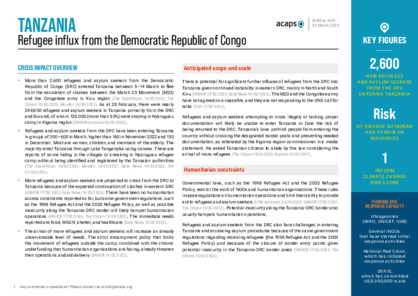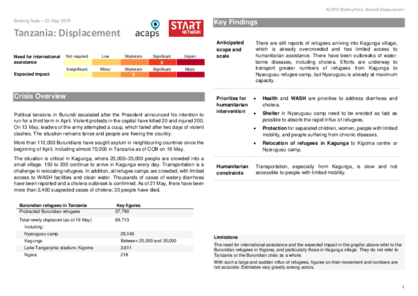Latest updates on country situation
24 September 2024
By the end of August 2024, there were 233,257 people displaced in Tanzania from other countries, mostly Burundi and the Democratic Republic of Congo. Among them, 192,389 (82%) are refugees, and 40,868 (18%) are asylum seekers. 192,270 (82.4%) are living in camps, 19,100 (8.2%) in settlements, 21,507 (9.2%) in villages, and 380 (0.2%) in urban areas. Shortages of funds continue to severely affect the lives of displaced people with limited WASH activities, medical supplies, and NFIs. (UNHCR 17/09/2024, (UNHCR 11/09/2024)
07 May 2024
On 4 May 2024, Tropical Cyclone Hidaya hit Mafia Island in Tanzania, leading to heavy rainfall and strong winds. Although the full impact of the cyclone is not yet known, Hidaya aggravated the already existing flooding situation in the country since August 2023. Between January–April 2024, the rains and floods killed at least 155 people, injured 236, and affected 200,000. Flooding also damaged 100,000 houses and inundated 76,700 hectares of farmland in Pwani and Morogoro regions alone. The impact of Hidaya is likely to further affect the livelihoods of the majority of the population, who depend on agriculture and livestock. School infrastructure, roads, bridges, and health facilities are also inundated. Floods have affected 14 of the 26 regions in Tanzania. Those affected likely need shelter, food, NFIs, and health services. (IFRC 08/05/2024, Xinhua 06/05/2024, The Independent 05/05/2024)
16 April 2024
Since the beginning of April, heavy rains have been affecting different regions of Tanzania. As at 15 April, at least 58 people died, over 1,500 were displaced, and nearly 127,000 were affected by the floods. The worst-affected area is the Rufiji district in the coastal region, with damage to infrastructure and livelihoods. Needs include shelter, food, WASH, healthcare, and protection. (Al Jazeera 15/04/2024, ECHO 16/04/2024, IFRC 10/04/2024)
05 December 2023
There has been heavy rainfall in northern, western, and eastern Tanzania since mid-October 2023, but particularly inclement weather in Manyara region, particularly Katesh village, since December 2 has led to landslides, resulting in at least 63 deaths, 116 injuries, and two missing people in Hanang district as at 5 December. Damaged roads and defective telecommunications challenge assessing the number of displaced people, but estimates go up to around 5,600 affected people. The heavy rains have also affected Nyarugusu refugee camp, suspending food distribution, medical services, and other critical activities. The affected people are likely to need shelter, food, NFIs, healthcare, and WASH services. (IFRC 23/11/2023, ECHO 05/12/2023, Mahoua Parums X 02/12/2023)
21 October 2023
In July 2023, the Ministry of Health in Tanzania confirmed a cholera outbreak in three regions: Arusha, Kigoma, and Mara. As at 8 October, there were 268 reported cholera cases, including nine deaths, putting the case fatality ratio at 3.3%. Most cases (61%) were recorded in Mara region, followed by Arusha (24%) and Kigoma (14%). The rainy season runs from November–April, which could heighten the risk of the disease spreading. (WHO 20/10/2023, FEWS NET accessed 24/10/2023)
26 September 2023
Since January 2023 until 19 September, 13,300 people fled from eastern Democratic Republic of Congo to Tanzania because of clashes between armed groups and government forces. These people have been relocated to Nyarugusu refugee camp, which hosts nearly 150,000 people. Limited resources are hindering the provision of humanitarian assistance in the camp. (UNHCR 20/09/2023, MPI 24/08/2023)
17 July 2023
As at 30 June 2023, Tanzania was hosting more than 255,400 refugees and asylum seekers mainly from Burundi and the Democratic Republic of Congo. About 84% of the refugees and asylum seekers, the majority of whom were children (55%), lived in camps in Katavi, western Kigoma, and Tabora regions, including about 132,000 people in Nyarugusu camp in Kigoma, near the Burundian border. Most refugees and asylum seekers lack adequate access to livelihood opportunities and face challenges in accessing food and nutrition. (UNHCR 17/07/2023, FAO 13/07/2023)
current crises
in
Tanzania
These crises have been identified through the INFORM Severity Index, a tool for measuring and comparing the severity of humanitarian crises globally.
TZA001 - Country level
Last updated 15/11/2024
Drivers
Displacement
Drought
Crisis level
Country
Severity level
2.5 Medium
Access constraints
2.0
TZA003 - Food security in North-East
Last updated 15/11/2024
Drivers
Drought
Crisis level
Country
Severity level
2.3 Medium
Access constraints
2.0
REG012 - Southern Africa Regional Food Security Crisis
Last updated 30/09/2024
Drivers
Crisis level
Regional
Severity level
3.8 High
Access constraints
3.0
TZA002 - Refugees
Last updated 15/11/2024
Drivers
Displacement
Crisis level
Country
Severity level
2.4 Medium
Access constraints
2.0
Analysis products
on
Tanzania
30 March 2023
Tanzania: Refugee influx from the Democratic Republic of Congo
DOCUMENT / PDF / 268 KB
More than 2,600 refugees and asylum seekers from the Democratic Republic of Congo (DRC) entered Tanzania between 5–14 March to flee from the escalation of clashes between the March 23 Movement (M23) and the Congolese army in Kivu region. The immediate needs reported are food, WASH, shelter, and healthcare.
18 March 2016
Tanzania: Displacement from Burundi
DOCUMENT / PDF / 487 KB
Political tensions in Burundi escalated after the President announced his intention to run for a third term in April. Violent protests in the capital have killed 20 and injured 200. On 13 May, leaders of the army attempted a coup, which failed after two days of violent clashes. The situation remains tense and people are fleeing the country.



